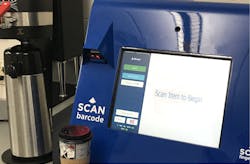Looking Ahead: Micro Markets And OCS Will Drive Growth
The past year has been positive for the industry. All industry segments — vending, micro markets and office coffee service (OCS) — experienced growth in revenues. The Automatic Merchandiser State of the Industry report showed an industry worth $21.6 Billion, a 7-year high. Micro markets specifically are capturing a small, but quickly increasing share of that revenue. In the Bachtelle and Associates 2017 Micro Market census report, initial projections have already been met, leading to unknown potential over the next 10 years. OCS too has recorded record breaking revenues thanks to more emphasis on how it can be a benefit to locations and employees by providing popular onsite snacks, food and beverages. Taking the growth drivers into account, there is a strong likelihood that the industry will see the same upward trajectory it has already experienced continue into 2018.
The micro market grab
Micro markets will experience continued growth in the next year. Currently, the majority of operators don't believe their areas are saturated, which leaves plenty of potential micro market locations to convert in 2018. Brad Bachtelle, president of Bachtelle and Associates, says that much has changed since his initial projections in 2013, which suggested a potential location number of 35,500 creating $1.6 billion in revenues (by 2022). In 2017, we have already reached nearly $1 billion in revenues with only 17,800 micro markets placed. Bachtelle uses this as evidence that the micro market segment has plenty of growth ahead with an ever-increasing cap to potential revenues due to operators continuing to improve on their service. In fact, part the of problem with projecting the total revenue of the segment is that the potential locations for micro markets continue to increase. Bachtelle notes in his research, published in the October/November 2017 edition of Automatic Merchandiser magazine, that the original requirements of profitable micro markets are no longer straight forward. The report states:
"The initial projection for the size of the micro market placement opportunity was based upon a general perception within the channel that location opportunities were restricted to businesses with employee populations between 150 and 500. Under 150, sales levels would not be adequate to deliver profit and justify the associated investment, while larger locations were already being served in most cases by on-site dining/foodservice installations that delivered hot meal service that micro markets could not effectively compete against."
This has changed. Now, Bachtelle reports that the threshold for the number of employees can be lowered to 125, or perhaps lower still to 100, and at times, 75 employees, depending on circumstances such as hours employees spend onsite and other refreshment options in the area. Also, larger locations are adding micro markets due to the focus on grab-and-go refreshment options as well as the benefit of having food available 24/7, unlike in a cafeteria. Combined, this creates a much larger pool of potential locations.
Saturated areas thrive
Even in areas where operators are feeling heavy competition for micro market locations, the revenues aren't suffering. Instead, operators are using the platform to diversify and highlight aspects of their service. Some micro market providers focus on fresh food, making it central to every micro market while balancing it with high quality snacks. Others are focusing on making micro markets work for smaller locations (those 75 to 100 employee locations).
Operators will continue adding micro markets in 2018 as they adapt the evolving micro market solutions from suppliers as well as create better operational efficiencies. Micro markets appeal to customers, drawing in more users than vending machines for a variety of reasons, including being able to offer a greater number of product options and allow customers to touch and look at items before purchasing. This will still be important in 2018, as will adding a greater number of healthy items as consumers continue to view this as important as well as offering nontraditional beverage options. In cold beverages, bottled water is gaining traction, surpassing carbonated soft drinks by volume according to the most recent report by Beverage Marketing Corp. The report stated:
"Bottled water had a truly significant year: it surpassed carbonated soft drinks to become the number-one beverage by volume. The category's essential traits — healthful, natural, calorie-free and convenient — increasingly appeal to U.S. consumers. Pricing remained aggressive, which also contributed to bottled water's performance. Its growth actually accelerated, which is unusual for a category its magnitude. Volume enlarged by 8.6%.
As they have for several years, niche categories outperformed most traditional mass–market categories. Ready–to–drink (RTD) coffee and value–added water in particular advanced forcefully in 2016. Larger, more established segments such as carbonated soft drinks and fruit beverages still failed to grow."
Single-cup and service
For hot beverages, specialty single-cup is driving much of the growth. This can sometimes be offered within a micro market, but more often is paid for by the location. Pantry service, or micro kitchen service, continues to grow. The benefits to the location mimic micro markets — a greater variety of products, especially healthy items; grab-and-go convenience; 24/7 offerings; etc. However, these items are paid for by the location and offered free to the employees, unlike most micro markets. There has also been some cross over among forward thinking micro market providers with subsidized markets for smaller locations. With unemployment rates projected to stay low as the economy strengthens leading to even more jobs, it's expected that more companies will be looking for additional ways to attract, retain and reward employees. There will be a focus on well-designed breakrooms that are Millennial, and even iGEN, friendly with social refreshment spaces that include café-style, at-work specialty beverages paired with healthy grab-and-go snack items.
With the benefits of micro market service and a corporate culture focused on offering perks to good employees, the industry is well-placed to enjoy a positive 2018.
About the Author

Emily Refermat
Emily Refermat began covering the vending industry in 2006 and served as editor of Automatic Merchandiser from 2012 to 2019. To reach the current editor of Automatic Merchandiser and VendingMarketWatch.com, email [email protected].
